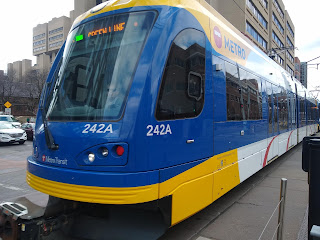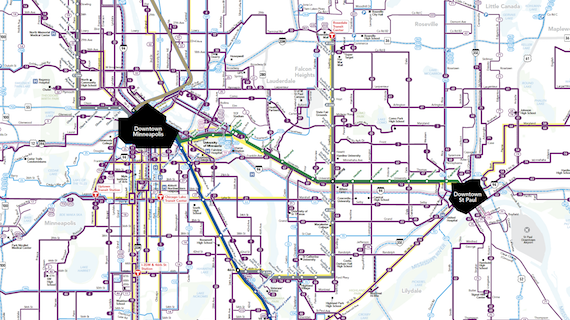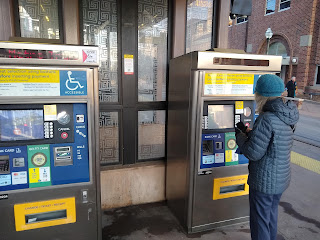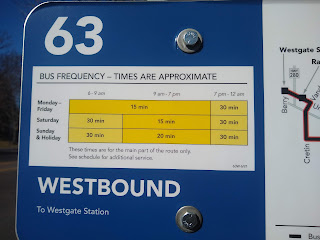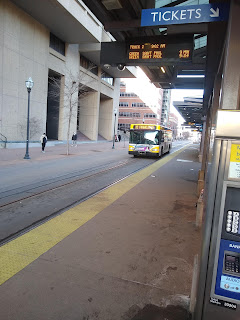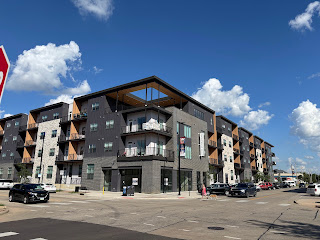It seems I'm always ready for March to bring Indian Creek Nature Center's annual maple syrup festival, even when the last two months in the Midwest hardly qualified as winter. Then Friday came a surprise snowstorm, thick goopy stuff that arrived so suddenly the schools didn't have time to cancel classes. It was already melting by Saturday, but enough remained to lend some scenery to the pancakes and sausages. The Nature Center estimated Sunday that 2700 people came through the lines over the course of the weekend, which means the staff and volunteers served at the rate of 300 people an hour!
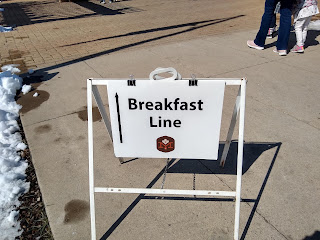 |
| This way to the pancakes! |
 |
| Hard at work over the griddles |
 |
| Waiting for the next batch: Untimely equipment failure created some brief backlogs |
 |
| Refilling the sausage tray |
 |
| Syrup was made from the Nature Center's own trees. Coffee donated by Caribou |
Most of our party had seconds, which encouraged an after-breakfast hike:
 |
| Woodland Trail view |
 |
| Along the trail: The old Bertram Road bridge has been repurposed |
 |
| Amazing Space building |
 |
| McCarty Wetland |
On a chilly morning, few if any people had their pancakes outdoors. There was plenty of room inside in the main hall, where we sat and where there was musical entertainment. People used the classrooms, too, where the ambience doubtless was quieter. We saw a few people we knew, and a lot of people we didn't. What a great place to see your community!
There were also demonstrations of syrup-making down the road at the former Nature Center space.
For the Nature Center, greeting 2700 happy pancake eaters, not to mention mobilizing two days' worth of volunteers, is a good way to promote the many ways it provides value to the community: trails, programs for all ages, acres of wild space, and modeling ecological living. I love the Nature Center, but I confess there are years where I go from maple syrup festival to maple syrup festival without ever getting back. It's good to be reminded that it's here, every day of the year, and doing a lot of good work.
This is particularly important as our warm winter signals the steady accumulation of climate change. I enjoy a clement day as much as anyone, but the last nine months have been the warmest on record worldwide, the oceans have never been this warm in human history, winters are getting warmer, and springs are getting earlier. Something is going down, something that we have only a partial notion of, and it's not going to be pretty. Or clement. It's messing with syrup production, too: this year Nature Center trees produced only 500 gallons of sap (last year they got 2000); the variability affects private producers, too, like Danno Potter of Garnavillo, who told the Cedar Rapids Gazette: It puts a lot of pressure on us. We can't be wrong.... I drink a lot of coffee in the morning thinking how I can (adapt) (Miller 2024). Coffee's going to be affected, too, of course! The Nature Center crowd knows all this, or most of them do anyway. They know we have to live with and in nature, not just put it on our pancakes, and even in a town where you can get anywhere in a car in 15 minutes.
Speaking of which, the Nature Center's remote location has given it room to expand in a genuinely unspoiled area, and to develop an impressive range of hiking trails on its large campus, but it's difficult to get there without a car. (This is shown by the jaw-dropping spread of parked cars during Nature Center events. Cars are bigger than people, of course.) As our metro trail network gets fleshed out, it will be easier to get there by bicycle, at least in the warm months. It's almost three miles from the nearest bus stop, at the Mount Vernon Road Hy-Vee, and there's far from being enough potential traffic to warrant extending the #2 line out this far. It's a conundrum.
 |
| Getting all those people there required a lot of cars |
Indian Creek Nature Center is on Facebook and Instagram and in the blogosphere. Not on Mastodon, yet, however.
SEE ALSO: "Maple Syrup Festival 2023," 26 March 2023





